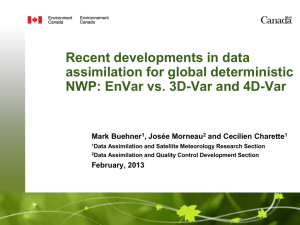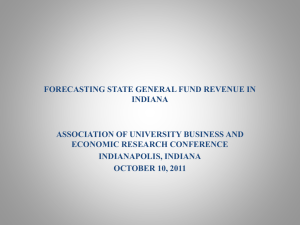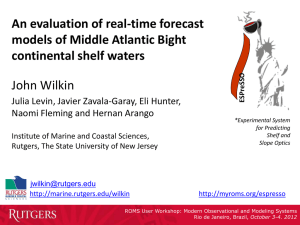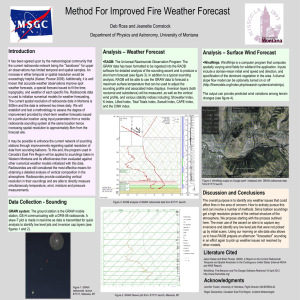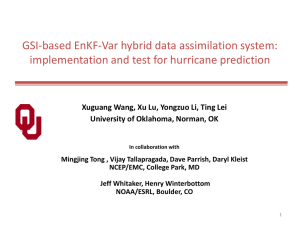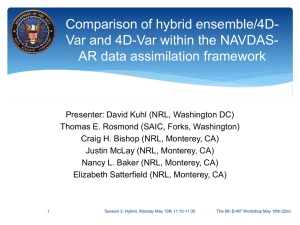4D-Var - Research and Development Center for Data Assimilation
advertisement
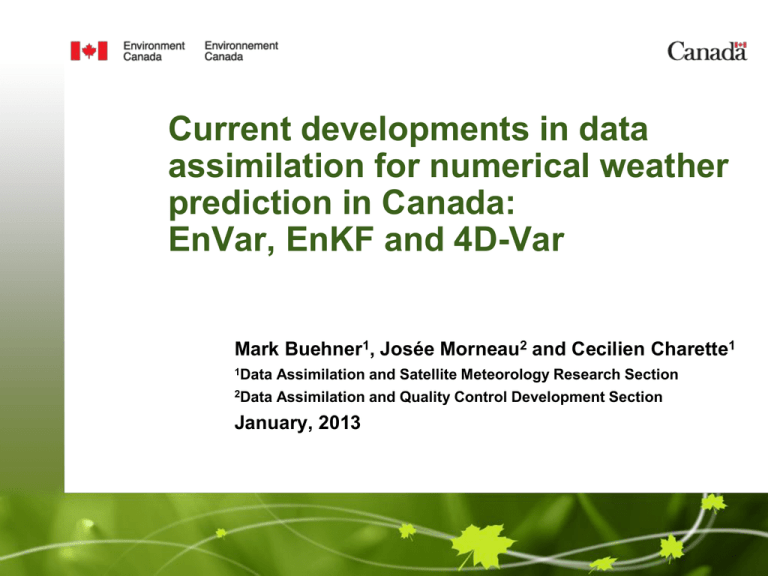
Current developments in data assimilation for numerical weather prediction in Canada: EnVar, EnKF and 4D-Var Mark Buehner1, Josée Morneau2 and Cecilien Charette1 1Data Assimilation and Satellite Meteorology Research Section 2Data Assimilation and Quality Control Development Section January, 2013 Contents • Background and recent changes to the Canadian NWP systems • The ensemble-variational (EnVar) data assimilation approach • Recent results from using EnVar compared with standard 3D-Var and 4D-Var (but NO comparisons with 4D-VarBens or EnKF) • Conclusions and next steps Page 2 – April-7-15 Background • Environment Canada currently has 2 relatively independent state-ofthe-art global data assimilation systems • 4D-Var (Gauthier et al 2007) and EnKF (Houtekamer et al 2009): – both operational since 2005 – both use GEM forecast model and assimilate similar set of observations – current effort towards unifying code of the two systems • 4D-Var is used to initialize medium range global deterministic forecasts (GDPS) • EnKF is used to initialize global ensemble forecasts (GEPS) • Intercomparison of approaches and various hybrid configurations was performed in carefully controlled context: similar medium-range forecast quality from EnKF and 4D-Var analyses, 4D-Var-Ben best • Results presented at WMO workshop on intercomparison of 4D-Var and EnKF, Buenos Aires, 2008 (Buehner et al 2010, MWR) Page 3 – April-7-15 Summary of recent changes Major improvements to DA of global and regional systems IBM Power7 New 10km/4DVar Regional Deterministic Prediction System… Oct Nov Dec Jan Feb Mar Apr May Jun Jul Aug Sep Oct 2011 2012 Nov Improvements to global & regional DA systems (Nov 2011) New Satellite Data - 62 infrared channels from the IASI instrument on board the METOP satellite. - 7 microwave channels from the SSM/IS instrument on board the DMSP F16 satellite. - 1 water vapor channel from the GOES-W, METSAT-1R and both METEOSAT satellites. - Horizontal thinning of all satellite radiance data, previously done at 250 km (except 200 km for SSM/I) was reduced to 150 km, therefore adding much more satellite data to the systems. Amount of data assimilated in the global system - increase from ~1.9 million to ~4.2 million pieces of information per day. Fig: GZ-500hPa anomaly correlations over the S. Hemisphere during the parallel run (Jan-Jun 2011): old vs new global system. Other Assimilation Changes - Moisture observations measured from properly equipped aircraft (AMDAR) are assimilated. - Unified satellite data bias correction scheme. Reduction of the time period to compute the bias corrections from 15 to 7 days. The same code is used for all radiance data. - Updated version of the RTTOV radiative transfer code for satellite radiance data. - New sea surface temperature analysis on a 0.2° grid. New IBM Power7 • 2 clusters; 8192 cores each • ~ 1/2 PFlops peak total • on average, performance gain per CPU about 2.7x compared to P5 CPU • System was installed off-site • Migration of operational jobs took a year to complete • Fully operational since early May 2012 Major upgrade of the Regional Deterministic Prediction System (RDPS) (Oct 2012) Upgrade included: • increase in resolution to 10 km from the previous 15 km • 4D-Var data assimilation system replacing the previous 3D-Var • important changes in the physics Fig: The red line indicates the domain covered by the RDPS. GZ T Significant improvements in forecasts with most metrics throughout most of the atmosphere, especially: • for the winter season • for the lower portion of the atmosphere and at the surface Fig: Vertical profiles of bias (dashed lines) and error standard deviation (solid lines) of 48-h forecasts against radiosonde data, over Canada during the winter 2011, from the old (15km) versus new (10km) RDPS. by the end of 2013 by Jan 2013 Upcoming NWP operational implementations Global Deterministic - resolution: from 33 km to 25 km - new vertical coordinates / grid + improved physics - 4D-Var analysis increments: from T108 to T180, ~100 km Global EPS - resolution: from 100 km to 66 km - analysis (EnKF): multi-scale (3x more assimilated data) Regional EPS - resolution: from 33 km to 15 km Global Deterministic - resolution: from 25 km to 15 km - from lat-lon to Yin-Yang grid - from 4D-Var to EnVar: main focus of this presentation - resolution of increments: from 100 km to 50 km - new sea-ice and land-surface analyses Global EPS - resolution: from 66 km to 50 km High-resolution System - single grid (2.5-km resolution) covering most of Canada GZ T Major upgrade of the Global Deterministic Prediction System (GDPS) (expected to become operational in early 2012) DA (4Dvar) forecast model Fig: Vertical profiles of bias (dashed lines) and error standard deviation (solid lines) of 120-h forecasts against radiosonde data, over the S. Hemisphere, during the summer 2011, from the old versus GDPS. horizontal resolution - from 33km to 25km - improvements seen in analysis cycle dynamics - new vertical coordinate - new vertical grid (from regular to Charney-Phillips) - reduction of errors in stratosphere - noise reduction; improved numerical stability and conservation properties orographic blocking - amplification of bulk drag coefficient - significant reduction of tropospheric errors in winter hemisphere boundary layer - turbulent hysteresis effect - reduction of errors associated with frontal inversions; improvement of upper-air scores physics outer loop inner loop - from 33km to 25km TL / AD - from 160km to 100km - t: from 45min (9 bins) to 18min (21 bins) background error statistics - from T108 to T180 minimization:# of iterations - from 55 (30+25) to 65 (35+30) - more data (AMSU-A and Aircraft) due to increase of # bins - all changes contributed to forecast improvements, roughly doubling the gain due to model changes Upgrade of Global & Regional Ensemble Prediction Systems (expected to become operational in early 2012) Changes to the Regional EPS • Model component - horiz. resolution: from 33 to 15km - vertical levels from 28 to 40 - improved treatment of stochastic physical tendency perturbations to avoid unrealistic precipitation rates - improved boundary layer parameterization • Assimilation component - no changes (i.e same initial conditions as the global EPS) Fig: Global verification (CRPS error) of temperature at 500hPa against radiosondes, ov OLD versus NEW GEPS, showing a gain in predictability of 12h and plus. Changes to the Global EnKF and EPS • multi-scale algorithm (horizontal localization varies vertically) • time-step: from 30 to 20min • horiz. resolution: from 100 to 66km • vertical levels: from 58 to 74 • topography filter • reduced thinning of observations (2.7 X number of assimilated radiances) • improved dynamics and physics Model Dynamics: New approaches for global grids Proposed Upgrades and Improvements to the MSC Data Processing for Radiosonde and Aircraft Data • Increased volume of data: selection of observations according to model levels • Revised observation error statistics • Revised rejection criteria for radiosonde data based on those used at ECMWF • Horizontal drift of radiosonde balloon taken into account in both data assimilation and verification systems • Bias correction scheme for aircraft temperature reports wind speed temperature operational 12h 48h Fig: Verification scores against radiosondes over the N. Hemisphere, Jan-Feb 2009 (dash = bias; solid = stde) proposed for both radiosonde & aircraft Impact of proposed changes • General short-range forecast improvements above 500 hPa in both wind and temperature fields • The temperature forecast biases are significantly improved due to the bias correction scheme for aircraft below 200 hPa and to the new rejection criteria for radiosonde humidity data above 2013-2017: Toward a Reorganization of the NWP Suites at Environment Canada Role of Ensembles… Perturbed members of the global prediction system (GPS) Global EnKF Regional EnKF Background error covariances Regional En-Var ? Background error covariances Global En-Var Control member of the global prediction system (GPS) global system High-res En-Var Page 14 – April-7-15 Perturbed members of the regional prediction system (RPS) Control member of the regional prediction system (RPS) High-resolution deterministic prediction system (HRDPS) regional system Ensemble-Variational assimilation: EnVar • EnVar approach is currently being tested in the context of replacing 4D-Var in the operational Global Deterministic Prediction System • EnVar uses a variational assimilation approach in combination with the already available 4D ensemble covariances from the EnKF • By making use of the 4D ensembles, EnVar performs a 4D analysis without the need of the tangent-linear and adjoint of forecast model • Consequently, it is more computationally efficient and easier to maintain/adapt than 4D-Var • Hybrid covariances can be used in EnVar by averaging the ensemble covariances with the static NMC-method covariances • Like 4D-Var, EnVar uses an incremental approach with: – analysis increment at the horizontal/temporal resolution of EnKF ensembles – background state and analysis at the horizontal/temporal resolution of the higher-resolution deterministic forecast model Page 15 – April-7-15 EnVar formulation • In 4D-Var the 3D analysis increment is evolved in time using the TL/AD forecast model (here included in H4D): J (x ) 1 2 • T 1 1 x B x T 2 In EnVar the background-error covariances and analysed state are explicitly 4-dimensional, resulting in cost function: J ( x 4D ) • 1 ( H 4D [ x b ] H 4D x y ) R ( H 4D [ x b ] H 4D x y ) 1 2 1 ( H 4D [ x b ] H x 4D y ) R ( H 4D [ x b ] H x 4D y ) T 1 2 T 1 x 4D B 4D x 4D Computations involving ensemble-based B4D can be more expensive than with Bnmc depending on ensemble size and spatial/ temporal resolution, but significant parallelization is possible Page 16 – April-7-15 4D error covariances Temporal covariance evolution (explicit vs. implicit evolution) EnKF and EnVar (4D B matrix): 192 NLM integrations provide 4D background-error covariances 4D-Var: TL/AD inner loop integrations, 2 outer loop iterations, then 3h NLM forecast -3h 0h Page 17 – April-7-15 “analysis time” +3h EnVar: a possible replacement of 4D-Var Overall, EnVar analysis ~6X faster than 4D-Var on half as many cpus, even though higher resolution increments Wall-clock time of 4D-Var already close to allowable time limit; increasing number of processors has negligible impact To progress with 4D-Var, significant work would be required to improve scalability of TL/AD versions of forecast model at resolutions and grid configuration used in 4D-Var Current focus for model is on development of higherresolution global Yin-Yang configuration that scales well Decision made to try to replace 4D-Var with more efficient EnVar if EnVar is at least as good as current 4D-Var Page 18 – April-7-15 Dependencies between global systems • GDPS: Current system (1-way dependence): xb Bgcheck+BC xb, obs 4D-Var xa GEM (9h fcst) xb obs GEPS: • xb EnKF xa GEM (9h fcst) xb GEPS relies on GDPS to perform quality control (background check) for all observations and bias correction for satellite radiance observations Page 19 – April-7-15 Dependencies between global systems • GDPS: Current system (1-way dependence): xb Bgcheck+BC xb, obs 4D-Var xa GEM (9h fcst) xb obs GEPS: • GDPS: GEPS: • xb EnKF xa GEM (9h fcst) xb With EnVar (2-way dependence): xb xb Bgcheck+BC xb xb, obs EnVar obs EnKF xa xa GEM (9h fcst) GEM (9h fcst) xb xb 2-way dependence (EnVar uses EnKF ensemble of background states) increases complexity of overall system 2 systems have to be run simultaneously Page 20 – April-7-15 Dependencies between global systems • GDPS: Current system (1-way dependence): xb Bgcheck+BC xb, obs 4D-Var xa GEM (9h fcst) xb obs GEPS: • GDPS: GEPS: • GDPS: xb EnKF xa GEM (9h fcst) xb With EnVar (2-way dependence): xb xb Bgcheck+BC xb, obs xb EnVar obs EnKF xa xa GEM (9h fcst) GEM (9h fcst) xb xb Another possibility with EnVar (1-way dependence): xb Bgcheck+BC xb, obs EnVar xa GEM (9h fcst) xb xb GEPS: xb Bgcheck+BC xb, obs EnKF Page 21 – April-7-15 xa GEM (9h fcst) xb EnVar formulation: Preconditioning • Preconditioned cost function formulation at Environment Canada: J (ξ ) 1 ξ ξ T 2 • 1 2 ( H 4D x b H x ξ y ) R T ( H 4D x b H x ξ y ) In EnVar with hybrid covariances, the control vector (x) is composed of 2 vectors: ξ 1ens ξ nmc ξ ξ ens • 1 ξ N en s ens ξ ens The analysis increment is computed as (ek is k’th ensemble perturbation divided by sqrt(Nens-1) ): x ξ nmc B nmc ξ nmc ens 1/ 2 1/2 1/ 2 N ens 1/2 k e k L ξ ens B nmc B nmc ens N en s e T e L k k k 1 k 1 • Better preconditioned than original “alpha control vector” formulation (with L-1 and 1/β in background term of J) • Most, but maybe not all, applications of the approach use the better preconditioned formulation Page 22 – April-7-15 Single observation experiments Difference in temporal covariance evolution EnVar • radiosonde • • • temperature observation at 500hPa observation at beginning of assimilation window (-3h) with same B, increments very similar from 4D-Var, EnKF contours are 500hPa GZ background state at 0h (ci=10m) + + contour plots at 500 hPa + + Page 23 – April-7-15 Single observation experiments Difference in temporal covariance evolution EnVar • radiosonde • • • temperature observation at 500hPa observation at middle of assimilation window (+0h) with same B, increments very similar from 4D-Var, EnKF contours are 500hPa GZ background state at 0h (ci=10m) + + contour plots at 500 hPa + + Page 24 – April-7-15 Single observation experiments Difference in temporal covariance evolution EnVar • radiosonde • • • temperature observation at 500hPa observation at end of assimilation window (+3h) with same B, increments very similar from 4D-Var, EnKF contours are 500hPa GZ background state at 0h (ci=10m) + + contour plots at 500 hPa + + Page 25 – April-7-15 Experimental results: Configuration EnVar tested in comparison with new version of forecast system currently being implemented in operations: • model top at 0.1hPa, 80 levels • model has ~25km grid spacing • 4D-Var analysis increments with ~100km grid spacing EnVar experiments use ensemble members from new configuration of EnKF: • 192 members every 60min in 6-hour window • model top at 2hPa, 75 levels • model ~66km grid spacing EnVar increments ~66km Page 26 – April-7-15 EnVar uses Hybrid Covariance Matrix Model top of EnKF is lower than GDPS Therefore, EnVar not expected to be better than 3D-Var above ~10-20hPa Also tested 75% Bens and 25% Bnmc in troposphere, but results slightly worse pressure Bens and Bnmc are averaged in troposphere ½ & ½, tapering to 100% Bnmc at and above 6hPa (EnKF model top at 2hPa) Also did preliminary tests with a full outer loop, but degraded the results Page 27 – April-7-15 Bens scale factor Bnmc scale factor scale factor Forecast Results: EnVar vs. 3D-Var and 4D-Var Radiosonde verification scores – 6 weeks, Feb/Mar 2011 U GZ T-Td |U| T EnVar vs. 3D-Var 120h forecast North extra-tropics Page 28 – April-7-15 Forecast Results: EnVar vs. 3D-Var and 4D-Var Radiosonde verification scores – 6 weeks, Feb/Mar 2011 U GZ T-Td |U| T EnVar vs. 3D-Var 120h forecast North extra-tropics Page 29 – April-7-15 U GZ T-Td |U| T EnVar vs. 4D-Var 120h forecast North extra-tropics Forecast Results: EnVar vs. 3D-Var and 4D-Var Radiosonde verification scores – 6 weeks, Feb/Mar 2011 U GZ T-Td |U| T EnVar vs. 3D-Var 120h forecast South extra-tropics Page 30 – April-7-15 Forecast Results: EnVar vs. 3D-Var and 4D-Var Radiosonde verification scores – 6 weeks, Feb/Mar 2011 U GZ T-Td |U| T EnVar vs. 3D-Var 120h forecast South extra-tropics Page 31 – April-7-15 U GZ T-Td |U| T EnVar vs. 4D-Var 120h forecast South extra-tropics Forecast Results: EnVar vs. 3D-Var and 4D-Var Radiosonde verification scores – 6 weeks, Feb/Mar 2011 U GZ T-Td |U| T EnVar vs. 3D-Var 24h forecast Tropics Page 32 – April-7-15 Forecast Results: EnVar vs. 3D-Var and 4D-Var Radiosonde verification scores – 6 weeks, Feb/Mar 2011 U GZ T-Td |U| T EnVar vs. 3D-Var 24h forecast Tropics Page 33 – April-7-15 U GZ T-Td |U| T EnVar vs. 4D-Var 24h forecast Tropics Forecast Results: EnVar vs. 3D-Var and 4D-Var Verification against ERA-Interim analyses – 6 weeks, Feb/Mar 2011 EnVar vs. 3D-Var 48h forecast, global domain no EnKF covariances transition zone ½ EnKF and ½ NMC covariances U RH GZ T Page 34 – April-7-15 Forecast Results: EnVar vs. 3D-Var and 4D-Var Verification against ERA-Interim analyses – 6 weeks, Feb/Mar 2011 EnVar vs. 3D-Var 48h forecast, global domain no EnKF covariances transition zone no EnKF covariances transition zone ½ EnKF and ½ NMC covariances ½ EnKF and ½ NMC covariances EnVar vs. 4D-Var U RH U RH GZ T GZ T Page 35 – April-7-15 Forecast Results: EnVar vs. 3D-Var and 4D-Var Verification against ERA-Interim analyses – 6 weeks, Feb/Mar 2011 EnVar vs. 3D-Var 120h forecast, global domain no EnKF covariances transition zone ½ EnKF and ½ NMC covariances U RH GZ T Page 36 – April-7-15 Forecast Results: EnVar vs. 3D-Var and 4D-Var Verification against ERA-Interim analyses – 6 weeks, Feb/Mar 2011 EnVar vs. 3D-Var 120h forecast, global domain no EnKF covariances transition zone no EnKF covariances transition zone ½ EnKF and ½ NMC covariances ½ EnKF and ½ NMC covariances EnVar vs. 4D-Var U RH U RH GZ T GZ T Page 37 – April-7-15 Forecast Results: EnVar vs. 3D-Var and 4D-Var Verification against ERA-Interim analyses – 6 weeks, Feb/Mar 2011 North extra-tropics 500hPa GZ correlation anomaly EnVar vs. 3D-Var EnVar vs. 4D-Var Page 38 – April-7-15 Forecast Results: EnVar vs. 3D-Var and 4D-Var Verification against ERA-Interim analyses – 6 weeks, Feb/Mar 2011 South extra-tropics 500hPa GZ correlation anomaly EnVar vs. 3D-Var EnVar vs. 4D-Var This is the only significant degradation seen vs. 4D-Var in troposphere; Not in radiosonde scores because it originates from south of 45°S (see next slide) Page 39 – April-7-15 Forecast Results: EnVar vs. 3D-Var and 4D-Var Verification against ERA-Interim analyses – 6 weeks, Feb/Mar 2011 120h forecast of 500hPa GZ - STDDEV 120h forecast of 500hPa GZ STDDEV - South extra-tropics Page 40 – April-7-15 Forecast Results: EnVar vs. 3D-Var and 4D-Var Verification against ERA-Interim analyses – 6 weeks, Feb/Mar 2011 Tropics 250hPa U-wind STDDEV EnVar vs. 3D-Var EnVar vs. 4D-Var Page 41 – April-7-15 Forecast Results: EnVar vs. 3D-Var and 4D-Var Verification against ERA-Interim analyses – 6 weeks, July-Aug 2011 North extra-tropics 500hPa GZ correlation anomaly EnVar vs. 3D-Var EnVar vs. 4D-Var Page 42 – April-7-15 Forecast Results: EnVar vs. 3D-Var and 4D-Var Verification against ERA-Interim analyses – 6 weeks, July-Aug 2011 South extra-tropics 500hPa GZ correlation anomaly EnVar vs. 3D-Var EnVar vs. 4D-Var Page 43 – April-7-15 Forecast Results: EnVar vs. 3D-Var and 4D-Var Verification against ERA-Interim analyses – 6 weeks, July-Aug 2011 Tropics 250hPa U-wind STDDEV EnVar vs. 3D-Var EnVar vs. 4D-Var Page 44 – April-7-15 Experimental results: 4D-EnVar vs. 3D-EnVar 3D version of EnVar also tested: only uses EnKF flowdependent ensembles valid at the centre of the 6h assimilation window, instead of every 60 minutes throughout the window 3D-EnVar compared with: • 4D-EnVar: impact of 4D vs 3D covariances, and • 3D-Var: impact of flow dependent vs stationary (NMC) covariances (both 3D) Page 45 – April-7-15 Forecast Results: 4D-EnVar vs. 3D-EnVar Verification against ERA-Interim analyses – 4 weeks, Feb 2011 North extra-tropics 500hPa GZ correlation anomaly 4D-EnVar vs. 3D-EnVar 3D-EnVar vs. 3D-Var Page 46 – April-7-15 Forecast Results: 4D-EnVar vs. 3D-EnVar Verification against ERA-Interim analyses – 4 weeks, Feb 2011 South extra-tropics 500hPa GZ correlation anomaly 4D-EnVar vs. 3D-EnVar 3D-EnVar vs. 3D-Var Page 47 – April-7-15 Forecast Results: 4D-EnVar vs. 3D-En-Var Verification against ERA-Interim analyses – 4 weeks, Feb 2011 Tropics 250hPa U-wind STDDEV 4D-EnVar vs. 3D-EnVar 3D-EnVar vs. 3D-Var Page 48 – April-7-15 Conclusions • Comparison of EnVar with 3D-Var and 4D-Var: – EnVar produces similar quality forecasts as 4D-Var below ~20hPa in extra-tropics, significantly improved in tropics – above ~20hPa, scores similar to 3D-Var, worse than 4D-Var; potential benefit from raising EnKF model top to 0.1hPa • EnVar is an attractive alternative to 4D-Var: – like EnKF, uses full nonlinear model dynamics/physics to evolve covariances; no need to maintain TL/AD version of model – instead, makes use of already available 4D ensembles – more computationally efficient and easier to parallelize than 4DVar for high spatial resolution and large data volumes – computational saving allows increase in analysis resolution and volume of assimilated observations; more computational resources for EnKF and forecasts Page 49 – April-7-15 Next Steps • Finalize testing EnVar with goal of replacing 4D-Var in operational global prediction system during 2013 in combination with other changes: – GEM global model on 15 km Yin-Yang grid – CALDAS: new surface analysis system based on an EnKF – modified satellite radiance bias correction scheme that gives conventional observations more influence on correction – improved use of radiosonde and aircraft data – additional AIRS/IASI channels and modified observation error variances for all radiances – increased resolution of EnKF 66km 50km • Testing of EnVar in regional prediction system as possible replacement of 4D-Var already started Page 50 – April-7-15
